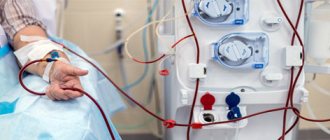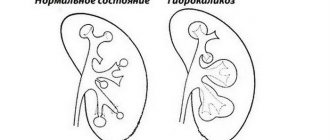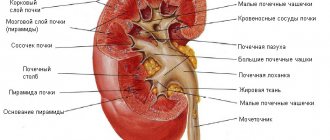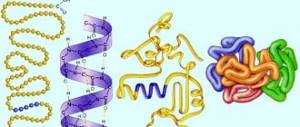When a person has chronic diseases, various unpleasant symptoms are present. Anemia in kidney disease is not uncommon; it occurs in the later stages of the pathological process. The symptom is associated with a damaged kidney, which ceases to produce sufficient quantities of the hormone responsible for the formation of red blood cells. For this reason, there is a shortage of red blood cells in the body, and especially in the kidneys. When their number drops to a minimum, renal anemia is diagnosed. With the disease, the level of hemoglobin decreases, which provokes an insufficient supply of oxygen to the body. Over time, oxygen starvation occurs, which can lead to death. Organ anemia requires timely identification and treatment to prevent irreparable complications.
The main causes of anemia in kidney disease
Renal anemia is also called nephrogenic or renal anemia. It is characterized by a decrease in the number of red blood cells and the level of hemoglobin in the blood in renal pathologies. There are several reasons that lead to the disease. The main reason for the development of renal anemia is the reduced synthesis of the hormone that produces red blood cells. This hormone is called erythropoietin, it regulates the formation and number of red blood cells in the blood.
During intrauterine development and in newborns, red blood cells are formed with the help of the liver. As the child grows, this function transfers to the kidneys. When the glomerular filtration rate decreases (less than 30 ml/min), then the amount of erythropoietin decreases, which leads to a decrease in hemoglobin. Due to kidney disease, toxic products are removed from the organ more slowly and accumulate, which also disrupts hormone synthesis.
Often the number of red blood cells is reduced due to an imbalanced acid-base balance associated with the accumulation of various acids. In case of chronic renal failure of the last stage, when the kidney has completely lost its functionality, the patient undergoes hemodialysis. It involves regularly drawing and purifying blood, thereby reducing the number of blood cells.
If the body does not have enough iron or folic acid, the normal production of red blood cells is disrupted. This often happens with renal failure - at its last stage, the intestinal mucosa is injured, and these substances cannot be normally absorbed from food in the required quantities.
Detoxification therapy for chronic renal failure in children
| Stage of chronic renal failure | Methods of therapy, indications and contraindications, doses | Duration of use, conditions of use |
| I—II | Hygienic bath, baths with pine extract, etc. Rubbing the skin with diluted vinegar, salt (sea) water, lotions | Daily |
| III | Enterosorption: activated carbon. An absolute contraindication is ulcerative process and/or gastrointestinal bleeding. Dose -1 g/kg/day | From 2 weeks to 10 months or more The daily dose is divided into 3-4 servings, which are taken 1.5 hours before meals and washed down with 100 ml of water. Other medications should be taken no earlier than 1 hour after the sorbent |
| IV | Dialysis, transplantation | Explanations in the text |
Most patients with chronic renal failure are able to maintain the fluid volume in the body and the concentration of electrolytes at the proper level until the onset of end-stage renal failure. In the early stages, the ability of the kidneys to concentrate urine is impaired, which is expressed in polyuria, iso- and hyposthenuria.
Symptoms
Renal anemia negatively affects the entire body, since as a result of oxygen deficiency, the functioning of all tissues and internal organs of the patient is disrupted. Symptoms do not appear immediately, since kidney anemia does not progress quickly. At first, there is a decrease in blood pressure. Over time, the following signs appear:
- headache;
- general weakness and fatigue;
- lack of sleep;
- irritability;
- lack of appetite.
As the disease worsens, abnormalities in the cardiovascular system are observed.
The patient begins to be bothered by constant shortness of breath after physical exertion, which eventually occurs in a calm state. Anemia is manifested by painful heartbeat and myocardial hypertrophy. Heart failure soon develops due to anemia. The patient's skin, mucous membranes and connective membranes turn pale.
The pathological process affects the functioning of the central nervous system. As a result of anemia, the patient is constantly depressed. There is a disorder of cognitive function. The disease has a negative impact on the patient's sexual function. In men, loss of sexual desire occurs, and in women, the menstrual cycle is disrupted.
Knowing the essence of the problem will help cope with renal anemia
Causes of the disease
The main impetus for the development of renal anemia is a decrease in the production of protein - erythropoietin. This type of protein is very important for the human body, as it regulates the production and maturation of red blood cells. During fetal life and after birth, the protein is produced in liver cells. As the child grows, erythropoietin begins to be synthesized in the kidneys. With kidney disease, the overall elimination of harmful substances slows down, as a result, the protein level decreases, the number of red blood cells drops, and less hemoglobin is synthesized.
With the development of acidosis, which implies a failure of the acid-base balance, acid accumulation occurs. This change in blood composition affects the rate of life of red cells, reducing this indicator by 2 times. Patients for whom dialysis procedures are indicated for progressive chronic renal failure are more likely to suffer from anemia. This is due to the fact that frequent, unnecessary blood sampling for tests, as well as the procedure itself, affect the progression of anemia. Diseases such as diabetes and hypertension can lead to the development of renal anemia.
How does it manifest?
Frequent headaches indicate the presence of renal anemia.
All internal organs and tissues suffer from anemia, as oxygen starvation occurs due to low hemoglobin levels. Anemia in kidney disease develops slowly, so at first it is quite difficult to diagnose the disease. After a certain period of time, the following symptoms characteristic of anemia appear:
- frequent headache;
- constant fatigue;
- general weakness of the body;
- sleep disturbance;
- aggressiveness and irritability;
- loss of appetite.
On the part of the cardiovascular system, slight deviations in functioning are possible as the disease progresses.
Patients note the presence of shortness of breath during mild and intense physical activity, while in a calm state it does not bother patients. With anemia, the heart rate increases and the condition of the myocardium worsens. Anemia in the body stimulates the gradual development of heart failure. With anemia, the patient's skin acquires a white tint. The nervous system is also negatively affected; the patient experiences constant depression, accompanied by aggression and irritability.
Complications and consequences
Anemia caused by kidney disease is fraught with dangerous consequences that threaten the patient with death. If the problem is not detected in a timely manner, it quickly leads to angina pectoris, causes bleeding in the gastrointestinal tract, and provokes hemorrhage in the brain. Anemia is the most dangerous for children, as it negatively affects their physical and mental development.
The most common and dangerous complication is heart failure, in which there is a lack of oxygen. For this reason, the heart increases its output of red blood cells. This provokes hypertrophy and decreased efficiency of the ventricle located on the left side. All these complications often cause sudden death of a person.
Fluid and salt requirements depending on the stage and complications of chronic renal failure
| Stage of chronic renal failure | Fluid and salt requirements * | Conditions of use |
| I—III | No restrictions on liquid or salt | Polyuria, no signs of heart failure, edema, arterial hypertension |
| III—IV | Fluid intake is determined by the volume of urine over the previous day, loss of water through perspiration (up to 5 years - 1 ml/kg/g, over 5 years - 0.5 ml/kg/g). Salt is limited to 1 mmol/kg/day, and sometimes to 0.2 mmol/kg/day (1 gNaCl = 40 mmol) | Diuresis less than 600 ml/m2/day, edema and arterial hypertension |
* daily salt requirement is determined by water balance (body weight, blood pressure, edema) and sodium excretion in urine
Hyperkalemia (serum potassium greater than 5.5 mmol/L) is usually observed with uremia.
Diagnostics
It is extremely important to promptly diagnose anemia in kidney disease. First of all, the patient is prescribed to donate blood for a general analysis - it will show at what level the hemoglobin is. When examining a person, doctors take into account his gender and age, since this is important when comparing the number of red blood cells and hemoglobin. For the female body, the norm for hemoglobin is 120 g/l, for men - 130 g/l. If test results are significantly lower than these indicators, anemia is diagnosed. The lower the hemoglobin level, the more complex the degree of pathology.
Additionally, an analysis is prescribed to monitor the activity of red blood cells. It is extremely important to determine what level iron and aluminum are at. In some cases, the patient is referred for a stool test to identify hidden bleeding in the internal organs. If a woman produces intense and large quantities of blood during menstruation, examination and consultation with a gynecologist is recommended. Therapy may be required to restore hormonal balance. When the results of all the studies are available, a diagnosis is made and the doctor prescribes individual therapy.
Key symptoms of kidney disease: what are the signs that your kidneys are unhealthy?
Small organs of the human body, the kidneys, play one of the most important roles in maintaining life. Normally functioning organs remove accumulated waste and excess fluid, cleanse the blood of toxins, maintain the required level of balance of chemical elements and regulate blood pressure.
Kidney diseases not only affect their condition, but also cause an inevitable deterioration in the functioning of other organs, which is characterized by a wide variety of symptoms.
Symptoms in men and women are not particularly different, which is explained by the same structure of the kidneys.
Types of diseases
Renal pathology can manifest itself as an acute or chronic disease. Symptoms and treatment depend on what kind of kidney disease a person has. Acute diseases occur abruptly and within a few days disrupt the basic functions of organs. Chronic diseases are characterized by the gradual destruction of kidney tissue, and sometimes it happens that the disease is discovered when it is no longer possible to return the original tissue structure, and in the process of drawing up a treatment regimen, they are guided only by the support of the organ.
Kidney diseases have similar symptoms and some differences from other diseases, which makes it possible to suspect organ pathology.
General symptoms
- Pain. Pain occurs in the lumbar region on one or both sides. It is also necessary to take into account the fact that for some renal pathologies pain is not typical or very insignificant, but can occur even with repeated exacerbations of the inflammatory process. Pain radiating to the pubis, upper thigh, and abdomen is characteristic of an attack of renal colic.
- Blood in the urine – hematuria. This symptom appears in urolithiasis, chronic pyelonephritis, inflammatory diseases, tumors. Urine turns pinkish, and if the ureter is damaged by a stone, it can be scarlet and opaque.
- Edema is one of the very first signs of glomerulonephritis and pyelonephritis. Swelling and puffiness first appear in the eyes in the morning, swelling of the legs and, least of all, the hands are observed. In children, swelling can be noticed by the deep rubber band marks on the legs.
- Impaired urination is characterized by pain, anuria - lack of urine, oliguria - a significant decrease in the amount of fluid released. With irreversible processes, constant pollakiuria develops - urine excretion in huge quantities, sometimes up to 10 liters per day.
- Bad feeling. As a result of the disruption of the basic excretory function of the kidneys, waste products and toxins accumulate in the body. All this affects the general well-being of a person - weakness appears, performance decreases, headaches and poor appetite are noted. The inflammatory process and intoxication of the body lead to increased temperature, chills, and sweating.
Chronic kidney diseases also affect the appearance of hypertension, the color and structure of the skin. With pyelonephritis, there is increased pallor and dark circles in the eye area; with glomerulonephritis, the skin is dry.
Naturally, each patient’s body reacts differently to changes in kidney function, so all symptoms can be mild or acute. Some patients report complaints of only one or two symptoms; often some signs of pathology transform into others. Depending on the disorders occurring and the causes of the disease, renal pathologies are divided into dozens of diseases.
Symptoms of kidney disease depending on the disorder
Pathological changes occurring in the kidneys are characteristic of different types of diseases. The initial diagnosis is made precisely on the basis of the patient’s complaints, so a qualified doctor begins the conversation by identifying all the disturbing symptoms, even the most minor ones.
Nephrolithiasis
The term nephrolithiasis refers to a disease such as kidney stones, that is, stones in the kidneys themselves. The disease must be distinguished from urolithiasis, in which stones are detected in all organs of the urinary system. Nephrolithiasis most often remains virtually asymptomatic for a long time. The disease occurs in two forms:
- The mild form occurs with constant dull pain in the lumbar region. The pain intensifies with physical activity, during shaking when driving.
- The severe form is manifested by sharp, unbearable pain. A sick person looks for the most painless position of the body - squats, bends. But the pain does not subside, but continues to radiate to the groin area, leg, and stomach. At the height of the attack, nausea, vomiting, and symptoms of shock may appear - cold sweat, pale skin, rapid heartbeat.
The movement of the stone down the ureter causes damage to its mucous layer, so blood may appear in the urine. Long-term progression of nephrolithiasis leads to the development of chronic pyelonephritis and at this stage symptoms of secondary pathology appear.
Glomerulonephritis
Glomerulonephritis is classified as an immune-inflammatory disease, that is, its development requires an inflammatory reaction and disturbances in the functioning of the immune system. Most often, glomerulonephritis is first recorded in children; the disease in most cases becomes chronic and causes renal failure and disability. Acute glomerulonephritis is characterized by:
- Urinary syndrome.
- Edema.
- Increased blood pressure.
As a rule, the disease begins with a deterioration in general well-being - headaches, fatigue, apathy appear, and a significant rise in temperature is possible, but only if the immune system is still at the proper level of functioning. In the morning, you can pay attention to the swollen eyelids; on the 3-4th day of development, oliguria appears - that is, a decrease in urine output, then its quantity increases, but at the same time low density is determined by analysis.
Most patients experience hematuria - the urine takes on a reddish color. In rare cases, the main symptom is proteinuria, that is, the release of protein in the urine. In approximately 60% of cases, high blood pressure numbers are recorded, and they can last up to three weeks or more.
As waste accumulates, the load on the liver increases, and the size of the organ increases accordingly. Nervous system disorders include irritability, poor sleep, depression.
Pyelonephritis
The most common kidney pathologies include pyelonephritis; its acute form develops abruptly and is characterized by:
- A big jump in temperature to 39 degrees or higher.
- Chills, sweating.
- Symptoms of intoxication - headache, nausea.
- Then lower back pain occurs and most often it is on one side.
- The pain can radiate to the lower abdomen and groin area.
- The urine is cloudy with signs of hematuria.
As the disease progresses, the pain becomes nocturnal and worsens when lying on your back. If pyelonephritis develops against the background of urolithiasis, then attacks of renal colic occur. Some patients experience facial puffiness.
Patients may experience increased fatigue, paroxysmal aching pain, and night sweats. The disease is often mistaken for osteochondrosis.
Polycystic kidney disease
Polycystic disease is characterized by the formation of fluid-filled cysts in the kidney tissue. At the beginning of its development, polycystic disease practically does not manifest itself in any way and can be an accidental finding during examination. The growth of cysts leads to expansion of the organ and at this time a group of signs appears:
- Aching pain in the lumbar region and abdomen.
- Hematuria occurs periodically.
- Weakness increases, appetite worsens, weight decreases.
- Copious amounts of light urine up to 3 liters per day.
- Dyspeptic disorders - nausea, diarrhea, constipation.
- Some patients complain of itchy skin.
Without treatment, polycystic disease creates the prerequisites for the development of severe renal failure.
Treatment of anemia
If a patient has renal failure at the pre-dialysis stage, then he is prescribed medications that contain iron and folic acid. At this stage, the products can be taken in tablet form. When hemodialysis is performed, all medications are injected into a vein. In this way, it is possible to increase and maintain hemoglobin levels at an acceptable level. Previously, blood transfusions were practiced in medicine as a therapeutic remedy for chronic renal anemia. Today, this method is practiced extremely rarely for the reason that dangerous infectious diseases are transmitted this way. Patients often experience allergies after a blood transfusion procedure.
In medicine, a drug has been created that allows the production of erythropoietin. With the help of recombinant erythropoietin, it is possible to improve the lives of patients with chronic deficiency and reduce the number of early deaths from anemia. This drug is recommended for patients whose hemoglobin level has dropped below 90 g/l. The drug is injected under the skin and the increase in hemoglobin is checked every two weeks. When the level rises, test results are requested every month. It should be taken into account that with excessive use of the drug, blood pressure increases and there is a risk of vascular thrombosis.
Complex therapy includes drugs containing iron, taken in tablets or intravenously. If a reduced amount of folic acid is noted, folate supplementation is recommended. If hemodialysis is not performed, then folic acid is prescribed in tablet form. During hemodialysis, the drug is administered intravenously. It is extremely important to begin treating anemia as early as possible to avoid unpleasant complications. You should contact qualified specialists to restore your health.
Chronic kidney disease
The kidneys are a kind of laboratory of the human body. During the day they pump a lot of blood, cleanse it of toxins and other harmful waste products. Disturbances in the functioning of this organ often lead to the development of complex and sometimes irreversible processes that not only reduce the quality of life, but can also cause the death of the patient. Clinical signs of diseases affecting the kidneys may have pronounced or hidden symptoms, but if their functionality is impaired for more than 3 months, a nephrologist can make a diagnosis of “chronic kidney disease,” which can manifest itself against the background of other sluggish pathologies of the urinary system.
In urology, chronic kidney disease is often called chronic renal failure, which is a serious disease in which there is disruption of the functioning of almost all organs and systems. What is CKD, how does it develop, what are the symptoms, types of disease, how to treat and what prognosis awaits the patient? You can get answers to these questions by reading this article.
What is CKD?
Chronic kidney disease (CKD) is a pathology that combines several conditions in which damage or decreased function of the glomerular filtration rate (GFR) occurs in the kidney tissues. During the development of this disease, the nephrons of the kidneys die or are replaced by connective tissue. Such pathological processes lead to irreversible disturbances in the functioning of the kidneys, which are unable to perform their functions of purifying the blood and removing excess water and absorbing electrolytes.
Chronic kidney diseases often develop against the background of a disorder of water, electrolyte, nitrogen or acid-base balance, which lasts for several months. The diagnosis of CKD is most often made by a doctor after the results of differential diagnosis, the results of which make it possible to determine the underlying disease that caused the development of pathologies of the urinary system.
Those at risk for developing the disease are those with a history of pathologies of the cardiovascular system, diabetes mellitus, neurological diseases or pancreatic diseases. According to statistics, this disease is diagnosed in 10% of the population of different age categories, including children.
When diagnosing CKD, the GFR indicator is considered important, which allows one to determine the number of dead nephrons. When the readings are less than 60 ml per minute, and there are significant disturbances in the functioning of the urinary system, we can talk about the death of half of the nephrons in the renal tissues, which is already considered a fairly serious pathology with irreversible consequences.
Causes
Chronic kidney disease most often develops in the presence of systemic or nephrological diseases, which may have indolent symptoms or manifest themselves with severe symptoms:
- chronic glomerulonephritis;
- chronic pyelonephritis;
- urolithiasis with impaired urine outflow from the renal pelvis;
- hydronephrosis;
- anatomical structure of the urinary system;
- malignant kidney lesions;
- systemic connective tissue diseases;
- arterial hypertension;
- acute renal failure;
- diabetes;
- hepatitis;
- gout;
- heredity;
- severe intoxication of the body;
- chronic alcoholism;
- polycystic ovary syndrome;
- long-term use of potent drugs;
In addition to the main causes, predisposing factors can act as a trigger for the development of this condition, including smoking, old age, regular nervous strain, and autoimmune disorders. Chronic kidney disease in children most often manifests itself as a result of a family history, when one of the parents suffers from severe pathologies or as a result of congenital defects.
Classifications and stages of the disease
The modern classification of CKD identifies 5 stages of the disease, each of which has its own characteristics, types according to stages of severity, and indicators of the level of glomerular filtration rate (GFR). Until recently, the stages of CKD consisted only of GFR indicators, but at the moment, when making a diagnosis, special attention is paid to other indicators.
If we consider the stages according to GFR, they can be divided into the following indicators of norm and deviation, but initially it should be noted that in a healthy person 80-120 ml min is considered normal.
Filtration rates at various stages:
- CKD stage 1. Accompanied by a slightly increased GFR from normal, on average 90 ml/min.
- CKD stage 2. Indicators decreased slightly, about 80-60 ml/min.
- 3rd stage. GFR in CKD c3a is moderately reduced and amounts to 60-30 ml/min.
- 4th stage. The GFR level is up to 30-15 ml/min.
- CKD stage 5. The most severe is terminal, in which GFR is less than ml/min.
In addition to GFR indicators, the classification of chronic kidney disease consists of the same stages of the disease, each of which has characteristic symptoms.
Stage 1 of the disease
The glomerular filtration rate is slightly increased, but there may be no symptoms or only minor symptoms. At this stage, tubulointerstitial syndrome, disorders of the urinary system, nephrogenic hypertension and other minor symptoms may be present. With timely diagnosis, it can be cured or kept under control, but if there is no therapy, the clinical picture will be more pronounced, and the disease itself will actively progress.
Stage 2 CKD
Clinical signs of stage 2, more pronounced than in the 1st phase of the disease. This syndrome most often affects older people. Stage 2 CKD is accompanied by such symptoms as:
- decreased daytime diuresis;
- increased thirst;
- chronic weakness;
- pale skin;
- swelling of the upper and lower extremities;
- heart rhythm disturbance;
- increased blood pressure;
- change in urine parameters in the analysis.
Stage 3 CKD
Compensated or CKD stage 3. accompanied by damage to the mucous membranes and disorders of other organs and systems. Daily diuresis can reach a volume of 2.5 liters, problems with the functioning of the cardiovascular system appear, renal blood flow is disrupted, which can provoke acidosis or anemia in CKD. In addition to the main symptoms, the clinical picture of stage 3 CKD is constantly increasing, the patient develops:
- heart rhythm disturbance;
- blood pressure surges;
- dry mouth;
- insomnia;
- dry mouth.
Stage 4
At this stage, the disease is severe and can lead to death. The patient has all the symptoms of chronic renal failure, and azotemia, oliguria or anuria are also present. In stage 4 CKD, the amount of urea and creatinine in the blood increases significantly, which should normally be excreted in the urine. Characteristic symptoms at this stage are:
- increased weakness;
- nausea;
- lack of appetite;
- dry mouth;
- decreased diuresis or its complete absence;
- swelling of the body;
- damage to the heart muscle;
- skin itching.
Stage 5
The last and most severe stage of the disease, in which a large amount of protein metabolism products and toxins accumulate in the patient’s blood, which significantly affects the functioning of all organs and systems. CKD stage 5 also called terminal, characterized by persistent symptoms of renal and cardiovascular failure, the functioning of the bronchopulmonary system is disrupted. The patient feels:
- constant fatigue;
- nausea, urge to vomit;
- complete lack of appetite;
- decreased daily diuresis;
- pronounced swelling;
- severe skin itching;
- ammonia odor from the mouth;
- convulsions, even paralysis;
- severe anemia;
- dyspnea;
- uremia.
At this stage, there is a high risk of developing internal bleeding; the patient requires constant medical supervision.
Regardless of the stages of chronic kidney disease, treatment should begin as early as possible. Timely diagnosis of the underlying disease that has led to impaired renal function will help significantly reduce the risk of complications that can be life-threatening.
Complications
If chronic kidney disease is not treated in time, the consequences can be irreversible and very disastrous. With constant disruption of organ function, the entire body suffers, so complications can have severe and irreversible consequences.
- fluid retention in the body.
- anemia;
- pathologies of the cardiovascular system;
- damage to the skeletal system;
- severe intoxication of the body;
- death.
Chronic kidney damage can combine a whole group of diseases that affect the organs of the urinary system, so before starting treatment, it is important to identify and eliminate the main etiological factor. Depending on the stage of chronic kidney disease, the stages can provoke certain disturbances in the functioning of internal organs, so the earlier the disease is diagnosed, the greater the chances of a successful recovery.
Diagnostics
In order to make a correct diagnosis of kidney dysfunction, you need to undergo a series of laboratory and instrumental tests, which will be prescribed by a nephrologist or urologist after taking an anamnesis and studying the patient’s medical history.
- Urine and blood analysis.
- Ultrasound of the kidneys and abdominal organs.
- Kidney CT.
- Contrast urography.
- Analysis of GFR indicators (determination of creatinine clearance).
The research results will help the doctor create a complete picture of the disease, make the correct diagnosis, and prescribe appropriate treatment. If necessary, the doctor may prescribe other research methods, including the use of the MDRD formula, which allows you to determine the exact cause of the disease and determine the indicators of CKD with GFR. The correct formulation of the diagnosis is the first step on the path to recovery. The main thing is to recognize the disease in time and take all necessary measures to treat it.
Treatment methods
Treatment of CKD always consists of a set of therapeutic measures that allow influencing the cause, symptoms, and reducing the risks of complications. Therapy directly depends on the stage of the disease, the cause, the age of the patient and the characteristics of his body. Complex treatment may include taking medications and following a diet. If the disease is diagnosed in the last stages, then the patient needs constant hemodialysis, which will cleanse the blood of toxins and prolong the patient’s life. Curing CKD in the later stages is difficult and almost impossible, and the only way to improve a person’s life is an organ transplant.
Conservative therapy gives good results only in the initial stages of the disease. Patients are prescribed a number of medications, dietary nutrition, and adherence to work and rest schedules. With the right treatment, you can slow down the progression of the disease, improve the functioning of the kidneys and other organs and systems.
Drug therapy
Drug therapy will reduce the symptoms of uremia, reduce the content of nitrogen metabolic products in the blood, accelerate their elimination, and also eliminate the root cause. Therapy may include taking the following groups of drugs:
- Angiotensin-converting enzyme inhibitors.
- Angiotensin receptor blockers.
- Vitamin D preparations.
- Statins.
- Anabolic steroid.
In addition to the main medications, the doctor prescribes other medications, the mechanism of action of which will be aimed at eliminating the symptoms of the disease. The choice of drug and therapeutic course should always remain with the attending physician.
Replacement therapy
If chronic kidney disease has reached stage 5, the only treatment option will be replacement therapy, which consists of blood purification using an “artificial kidney.”
- Hemodialysis.
- Peritoneal dialysis.
- Kidney transplant.
A kidney transplant operation has high risks and high costs, and is also often complicated by finding a donor. People with advanced CKD sometimes undergo hemodialysis for decades, performed once or more times a week. Without hemodialysis, a person dies within a few months or weeks.
Nutrition for CKD
An integral part of treatment and prevention is considered to be a diet for chronic renal failure, which must be followed at all stages of the disease. Patients with impaired renal function are prescribed table No. 7a, b, p, which includes limiting protein foods. Patients are recommended to switch to plant protein and adhere to a vegetarian diet. The diet consists of limiting the following foods:
- cottage cheese;
- fatty meats;
- fish;
- legumes;
- any alcohol;
- butter.
It is important to reduce your salt intake. The patient is recommended to take no more than a third of a teaspoon per day. It is strictly forbidden to consume spicy, fried, fatty foods, as well as strong coffee and alcohol. Eating prohibited foods puts a significant strain on the kidneys. Patients are recommended to do “fasting days” or follow a mono-diet 2 times a week, which will consist of eating one product during the day.
When the patient is on dialysis, the diet, on the contrary, should consist of eating protein foods. It is recommended to consume at least 1 g of protein per 1 kg of body weight per day, and amino acids should also be included in the diet. The energy value of food should be 30–35 kcal per 1 kg of weight per day. An approximate menu will be prescribed by the attending physician individually for each patient.
Chronic kidney disease, treatment should always be prescribed by a doctor. This will increase the chances of a successful forecast.
Forecast
With proper and timely treatment of kidney disease, the patient has every chance of a full recovery, but when CKD reaches the 4th or 5th stage of the disease, full recovery can only be achieved with the help of a kidney transplant.
Prevention
To reduce the risk of developing chronic kidney disease, it is necessary to promptly and correctly treat all concomitant diseases of the urinary system and internal organs. The following preventive measures will help reduce the risk of developing pathologies affecting the kidneys:
- quitting smoking and alcohol;
- proper and healthy nutrition;
- weight control;
- proper treatment of all concomitant diseases;
- absence of stress and nervous tension;
- regularly boosting immunity.
Kidney diseases are quite difficult to treat, but with timely diagnosis and proper therapy, it is much easier to reduce the risk of their complications. It is important to understand that preventing a disease is much easier than treating it, therefore, at the first sign of it, you should not hesitate to visit a doctor and in no case should you self-medicate.
Reasons for decreased response to Epoetin drugs
The effectiveness of erythropoietin administration has been proven for people of all ages, including the elderly, elderly patients and young children. Data from multicenter studies confirm a good response to treatment with this drug. Over 4 months of observation, the hemoglobin level in severe renal anemia rose by 20 units.
A reduced response to the administration of such drugs was observed when other causes of decreased hemoglobin were identified - severe iron deficiency, deficiency of vitamin B12, folic acid, or in the presence of chronic unidentified hemorrhages.
- How to increase hemoglobin in a cat with chronic kidney disease
DETAILS: Red blood cells in the urine of women are normal and the number is increased.
Necessary examination
In addition to insufficient EPO production, the pathogenesis of the disease can have various origins. Diagnostics is intended to characterize the type and degree of the clinical course of the pathology, the concentration and activity of iron necessary for erythropoiesis, and to exclude anemia of other origins. If there is no iron deficiency due to blood loss, side effects of taking cytostatic drugs, the presence of tumors, or a malfunction of systemic hemolysis, then the reason is low EPO production.
Treatment of iron deficiency in patients with chronic renal failure
If a patient with renal failure has a ferrum deficiency, treatment consists of prescribing drugs aimed at restoring the depot of this element. They are usually prescribed in tablet form. If the digestive organs are damaged, they are administered parenterally.
Subcutaneous administration of erythropoietin helps improve the quality of life of patients with anemia due to kidney disease as part of complex therapy. Anemia responds well to treatment with this drug due to its effect on one of the stages of the pathogenetic chain. The important point here is that an overdose of a drug can lead to complications such as hypertension and thrombosis.
Therapy for anemia in chronic renal failure includes iron-containing medications, folic acid, and vitamin B12. Sometimes during hemodialysis, doctors move away from tablet drugs, preferring intravenous or intramuscular administration.
The patient's condition improves significantly after kidney allotransplantation, but such a step is only permissible when an organ is transplanted from close relatives with full antigen compatibility. Such patients are under lifelong observation by a nephrologist and transplantologist.
Causes
The cause of anemia of chronic disease can vary. Usually several processes are involved simultaneously. Anemia may be caused by a slight reduction in the normal survival rate of red blood cells. In addition, the production of red blood cells (erythropoiesis) or erythropoietin (a hormone that stimulates red blood cell production) may be impaired. Red blood cells carry oxygen to the body. The exact cause of anemia of chronic disease may depend on the underlying condition occurring in the patient's body. For example, in cancer , cancer cells can secrete certain substances that damage or destroy immature red blood cells. In some cases, cancer cells or infections can invade the bone marrow, the soft, spongy material found in long bones where blood cells are made.
Researchers also learned that people with anemia of chronic disease have an imbalance in the distribution of iron in the body and, as a result, are unable to effectively use iron to create new blood cells, despite adequate or elevated tissue iron levels. Iron is a critical mineral found in all cells of the body and is essential for normal functioning and growth of the body.
Target hemoglobin and stages of treatment with Epoetin
The effects of the administration of this drug is an increase in hemoglobin with hematocrit. The functioning of all organs and tissues improves by reducing hypoxia. Treatment with the drug involves two stages:
- initial, anemia is corrected;
- supportive to stabilize the patient's condition.
Doctors recommend keeping the hemoglobin level at least 110 g/l, since anemic syndrome is a decrease in this indicator below the indicated figure.
Read also Anemia in women during breastfeeding
Recommendations for preventing pathology
Primary prevention of the disease involves diet therapy based on the consumption of foods containing iron and cobalt:
- legumes (peas, beans, lentils);
- vegetables and fruits (pomegranate, beets, radishes, carrots, apples, lingonberries);
- egg yolk;
- buckwheat grain.
Timely diagnosis and treatment of anemia using dialysis and replenishment of iron deficiency are also important. Therapy of diseases of the pathogenesis of chronic renal failure (glomerulonephritis, urolithiasis, pyelonephritis).
Prevention of anemia involves identifying the hereditary factor of nephropathy, congenital kidney anomaly, and chronic inflammatory process in the organ. Particular attention is paid if there is a history of trauma with large loss of blood, burns, chemical intoxication, or exposure to radiation.
Clinical effects of Epoetin drugs
The administration of Epoetin alfa and Epoetin beta stimulates the formation of red blood cells well. Blood parameters such as reticulocytes, hemoglobin, and hematocrit improve. The rate of iron uptake by cells increases. The drug does not affect leukopoiesis.
In oncological diseases of the blood, erythropoiesis occurs, accompanied by intramarrow hemolysis, and therefore the onset of the clinical effect is delayed by 2-3 weeks, or does not occur at all.
Among the side effects of the drug are the following.
- Development or worsening of arterial hypertension, as well as the possible occurrence of hypertensive crises with complications - disturbances of consciousness, severe headaches, dizziness, disorientation in space.
- Thrombosis, thromboembolic phenomena.
- Worsening of ischemic processes, intensification of angina pectoris.
- Development of partial red cell aplasia.
- A decrease in the number of platelets, this condition is especially common with intravenous administration of erythropoietin.
Laboratory indicators include an increase in the concentration of potassium and blood phosphates. The amount of ferritin and iron decreases, but the hematocrit increases. Sometimes allergic reactions such as:
- itching of the skin with rashes, even urticaria;
- with individual intolerance, anaphylactic shock develops.
Other types of side effects are migraine-type headaches, hyperthermia, chills, joint pain, redness of the skin at the site of erythropoietin injection.
Signs and symptoms
Anemia of chronic disease varies in severity from one person to another. In most cases, anemia is usually mild or moderate. Affected people may develop various symptoms, such as:
- fatigue;
- pale skin;
- dizziness;
- difficulty breathing (shortness of breath);
- rapid heartbeat (tachycardia);
- irritability;
- chest pain, etc. signs.
These symptoms can occur in any person who has a comparable degree of anemia. In most cases, symptoms associated with the underlying disease usually take precedence over symptoms of mild or moderate anemia.
In rare cases, anemia of chronic disease can be severe and cause more serious complications.











